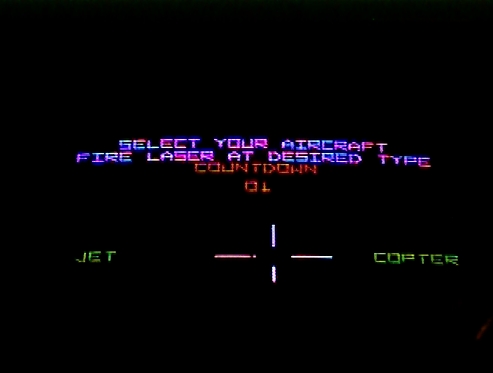
Jed Margolin - February 18, 2001
I started TomCat late in 1983. It was my next XY project after Star Wars and was almost immediately interrupted when I was abducted to work on Firefox.
Most projects started out by putting together a core project team consisting of a Project Leader, Hardware Engineer, Programmer, and Technician. Sometimes the Programmer was also the Project Leader and sometimes there was more than one Programmer.
TomCat was different. It was a Research Project.
My plan was to develop the hardware and write some 3D software to demonstrate its capabilities. Then I would recruit a team to do a flight simulator game.
I started out by using Star Wars hardware. Greg Rivera, the lead Star Wars programmer (Norm Avellar was the other programmer) modified the Star Wars program to give me software hooks so I could put in my own graphics.
I still have this boardset and recently fired it up to show Scott Evans (www.safestuff.com) and Bill Esquiviel.
Here are some screen shots.
This is the opening screen where the player can choose between flying a fixed-wing jet and a helicopter. (Only the helicopter was implemented.)

The Universe shows a horizon line, a head-up display, some simple objects on the ground to provide a reference, and a BattleZone tank (also on the ground). The BattleZone tank is the green thing in the mid-lower right of the picture.
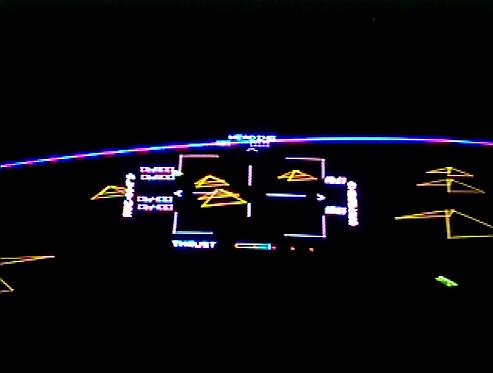
Here is a close-up of the tank.

There is also an enemy helicopter that came from Army BattleZone. The object was designed by Hans Hansen. I didn't get around to giving it a main rotor.
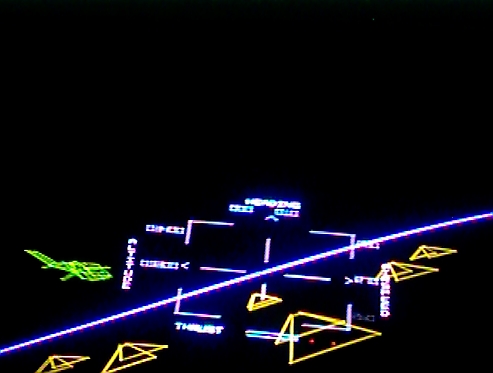
I gave it very rudimentary helicopter aerodynamics, but you do have full three-axis control.

Here we are in barrel roll.
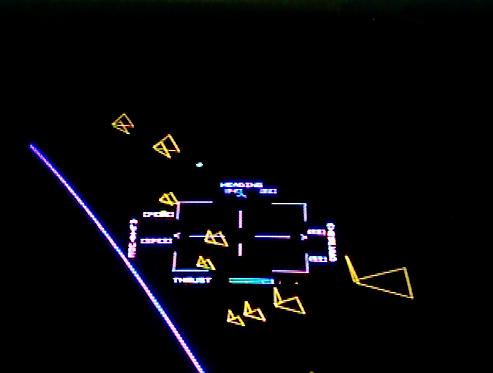
Now it was time to design hardware.
TomCat was very different from Star Wars.
My first design used a new processor from National Semiconductor, the 16032, which had a 32 bit internal bus and a 16 bit external bus. Other members of the family had an 8 bit external bus or a 32 bit external bus.
I bought National Semiconductor's evaluation board and interfaced it to a Star Wars AVG board.
The evaluation board had two serial ports. One went to a dumb terminal and the other was connected to the VAX. All of the commands from the dumb terminal were routed through the VAX before they went sent to the evaluation board. Because the VAX was almost always busy (i.e. slow), it would frequently take several seconds between typing a command and seeing it on the screen. It was a nightmare. There was also the small problem that there was no way to edit the command line, not even backspace. If you made a mistake you could delete the entire line and start over, that was all.
Nevertheless, I did get it working.
It was around this time that Atari went supernova. A few months later, after Warner Communications had given Atari Consumer to the Tramiels, when I called my National Semiconductor Representative he said,
" Umm, well, Jed, my title is Major Accounts Representative, and, umm, uh..."I finished his sentence,
"we are no longer a Major Account."He said,
" Yes,"and then proceeded to turn me over to an Underling, who did not return my calls.
At this point, although I had invested several months in the project, I decided to cut my losses. The hardware no longer exists and I did not archive the software. There was no point in saving it since it only worked when it was connected to a VAX.
The 16032 was not a big success for National Semiconductor. (Big surprise.) They renamed it the 32016, promoted it as an embedded processor, and even conned at least one printer manufacturer into using it.
And, of course, National Semiconductor went on to become hugely successful
in the microprocessor business. Not.
TomCat used a 6MHz 68010 for the Main Processor while Star Wars had a 3 MHz 68B09E.
TomCat used a Texas Instruments TMS32010 DSP for the math calculations while Star Wars used a state machine controlling serial multipliers. (The TMS32010 DSP was one of the first DSPs and had only recently been introduced.)
TomCat had a parallel game link interface while Star Wars had a serial port on the Pokey which was never used to link games, although I did use it to control the Powered Moving Seat.
TomCat was my first use of the Timekeeper RAM which featured a 2Kx8 static RAM with a built-in lithium battery, a power switching circuit, and a clock/calender. Star Wars had used a EAROM with slow write times and had a limited number of write endurance cycles. Since the Timekeeper RAM used a standard low-power SRAM it could be written at standard SRAM speeds and had an unlimited number of write endurance cycles.
TomCat used the same Analog Vector Generator (AVG) as Star Wars. Late in the project I figured out how to dramatically improve the vector quality. The details will have to wait for a future article on how XY hardware works.
For Sounds I incorporated the system requested by the newly formed Sound Group which had a 6502, two Pokeys, the Texas Instruments TMS5220 speech synthesizer that I used in Star Wars, and a Yamaha FM Synthesizer chip set.
And, finally, TomCat used a single four-layer PCB while Star Wars had a stack of three two-layer boards.
Here is a picture of the TomCat PC Board. This is Board #2, which has an Oops Board in place of the Vector Generator Gate Array. This board does not have the AVG mods to improve the vectors.
Here is a much better high resolution picture
(courtesy of Scott Evans).
This is the only working TomCat that I know of.
I have the parts to put together one more in order to show the ability to link two TomCats together. (I believe this is the first time anyone had linked together two 3D coin-op games.)
The TomCat pictures were made with a Kodak DC25 Digital Camera.
The camera is courtesy of Scott Evans. (Thank you, Scott.)
Tomcat never had its own cabinet.

The Welcome Screen. The plan was to offer the player an F14 (Tomcat), a helicopter, or a Cesna 150. Only the F14 was implemented. It featured rudimentary fixed-wing aerodynamics but had full three-axis rotation capability.
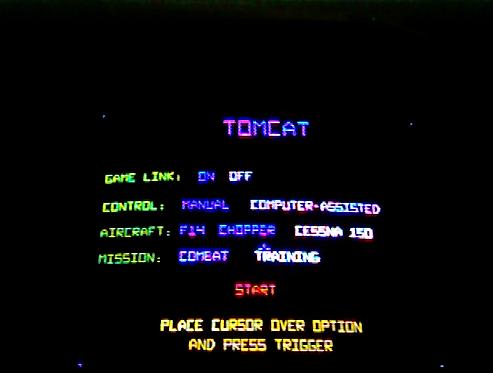
I put several objects in one of the Self-Test screens just to show how objects could be rotated. Here is the helicopter (with no Main Rotor) from Army BattleZone.
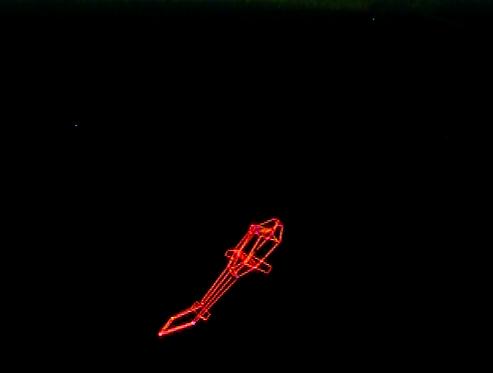
Here is our aircraft. I believe it was designed by Doug Snyder.
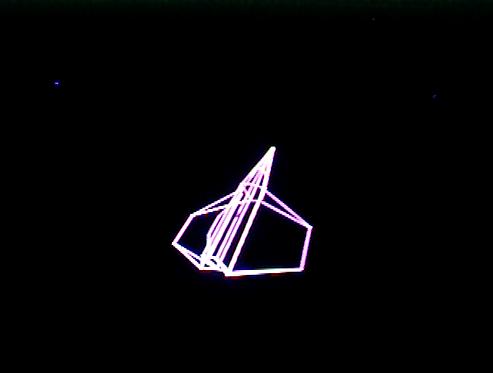
This is the tank from BattleZone. (The tank's radar seems to have fallen off.)
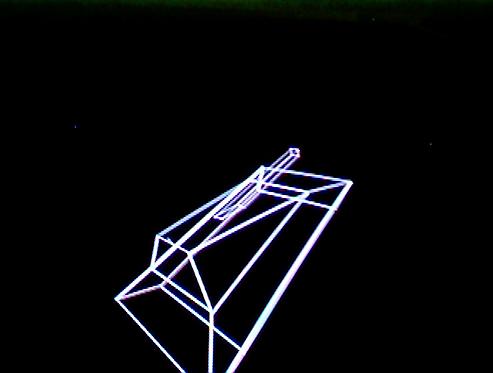
Here we are, just flying around. We have a head-up display and there is a self-propagating grid on the ground, stars in the sky, and a horizon line. All of these provide the pilot with a reference to avoid becoming disoriented.
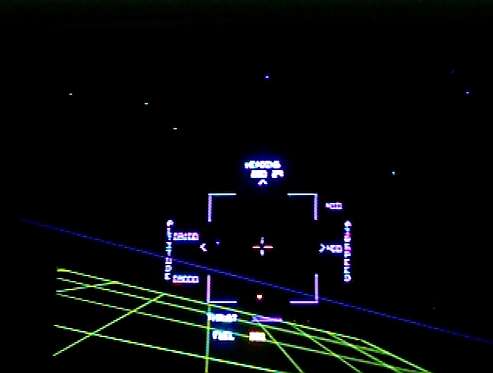
We can fly upside down if we want to.
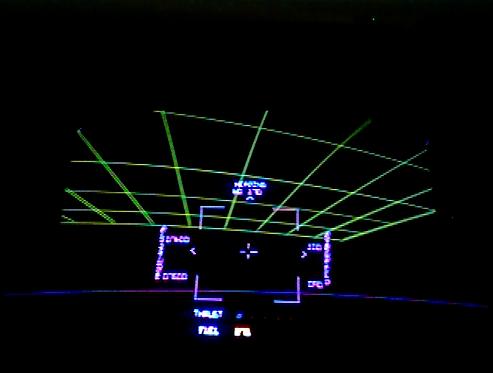
There's a runway out there. It even has rabbit lights.
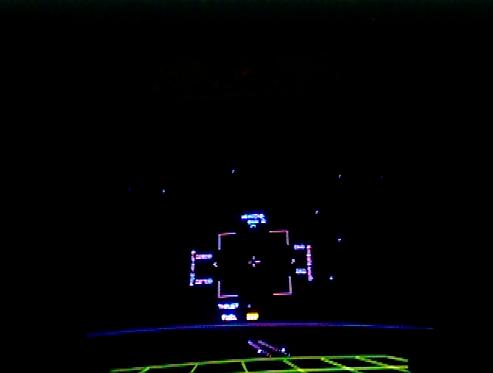
Ono, another TomCat.

There are stars in the sky. And you can see the runway lights on the ground.
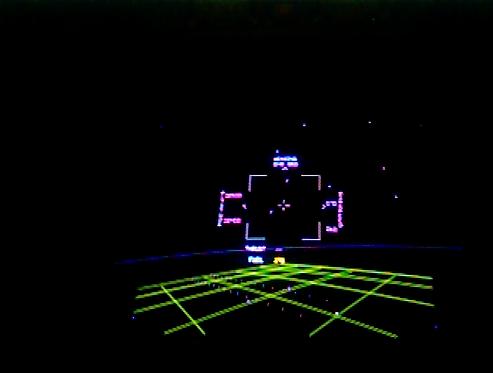
What Happened To It?
By late 1985 Atari had decreed that XY was dead, and despite my demo (which featured two linked TomCats) I was unable to get any of the Game Designers interested in working on it.
Shortly before the demo, when I was costing the hardware, I had called American Microsystems Inc. (AMI) to verify the cost of the VG Gate Array.
They said that they had contacted someone at Atari and asked him if it was ok if they threw out the tooling for the VG Gate Array and he had said, "yes." And no, they didn't remember his name.
They were willing to create new tooling for $20K.
I was planning to investigate using a TMS32010 DSP to replace the AVG State Machine (and the Gate Array along with it), but the handwriting was on the wall so I cancelled TomCat and accepted Rick's invitation to join the Hard Drivin' team.
|
|
Please send comments to: comments@jmargolin.com